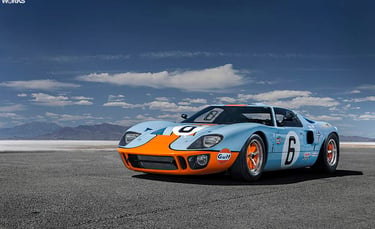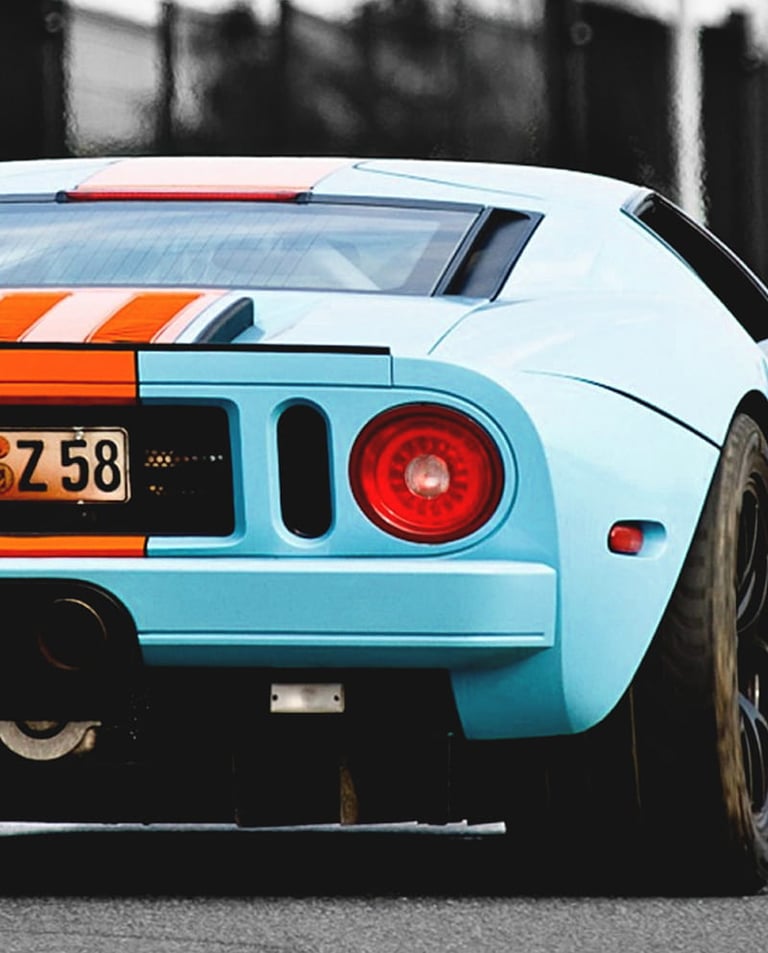Ford GT40 Gulf Miniature 1:18: The Blue and Orange Icon That Conquered Le Mans
Some cars transcend the track and enter the collective imagination as true legends. This is the case with the Ford GT40 Gulf, which not only won the 24 Hours of Le Mans but also became one of the most iconic racing supercars of the 20th century. Its light blue paint job with orange accents, supplied by Gulf Oil, became so famous that it is still replicated on modern cars, clothing, and collectibles. More than just a pretty color, this car symbolizes a time when Ford challenged Ferrari and wrote one of the most memorable chapters in motorsports.
RACE CARS
Driven Vault
9/4/20252 min read


History and Origin
In the 1960s, Henry Ford II sought to place the American brand at the top of endurance racing. After the failed negotiations to buy Ferrari, Ford decided to create a car capable of defeating the Italians on their home turf: Le Mans.
Thus, the Ford GT40 was born in 1964. But its peak would come in 1968 and 1969, when the car, now under the management of the John Wyer Automotive Engineering team and sponsored by Gulf Oil, achieved consecutive victories at Le Mans.
Chassis P/1075, painted in Gulf colors, became legendary with two consecutive victories at Sarthe—a historic feat that cemented Ford as a dominant force in endurance racing.
Cultural Impact and Exclusivity
The Ford GT40 Gulf wasn't just a winner on the track. It became a cultural symbol: It was immortalized in cinema, most notably in the classic Le Mans (1971), starring Steve McQueen.
It became the inspiration for the modern Ford GT Heritage Edition, launched decades later with a blue and orange paint job. It is one of the most valuable racing cars in the world—original examples have sold for over $10 million at auction.
Rare Facts
Legendary chassis: The GT40 Gulf P/1075 was the first car to win Le Mans twice in a row with the same chassis.
Ultra-low: At just 1.02 m tall, the GT40 required tall drivers to adapt to fit in the cockpit.
Million-dollar auctions: In 2012, an authentic GT40 Gulf sold for over $11 million at auction.


Design and Engineering
The GT40 was a car designed to win. Its name already indicated the overall height of the body: 40 inches (1.02 m), which made it extremely low and aerodynamic.
Design highlights:
Fiberglass and aluminum body, light and strong.
Low and wide lines, ideal for high-speed stability.
Functional air intakes, which cooled the V8 engine during 24-hour races.
Gulf blue and orange paintwork, which became the most famous color scheme in motorsports history.
Engineering focused not only on speed but also on durability—a key factor in demanding endurance racing.
Technical Specifications
In its Le Mans-winning Gulf configuration in 1968 and 1969, the GT40 boasted impressive performance for its time:
Engine: 4.9-liter Ford V8 (289 cu in)
Power: approximately 450 hp
Transmission: 5-speed ZF manual
Weight: ~1,200 kg
Top speed: approximately 340 km/h
0–100 km/h acceleration: approximately 4.5 seconds
These specifications made the GT40 a fast yet reliable car, capable of withstanding 24-hour marathons against rivals like Ferrari and Porsche.


Ford GT40 Gulf
The Ford GT40 Gulf is more than a race car—it's an immortal motorsport legend. Its combination of historic victories, iconic design, and rarity have made it one of the most sought-after vehicles on the planet.
Even decades after its Le Mans triumphs, its blue and orange paint job remains a symbol of passion for speed, epic rivalry, and cutting-edge engineering.
